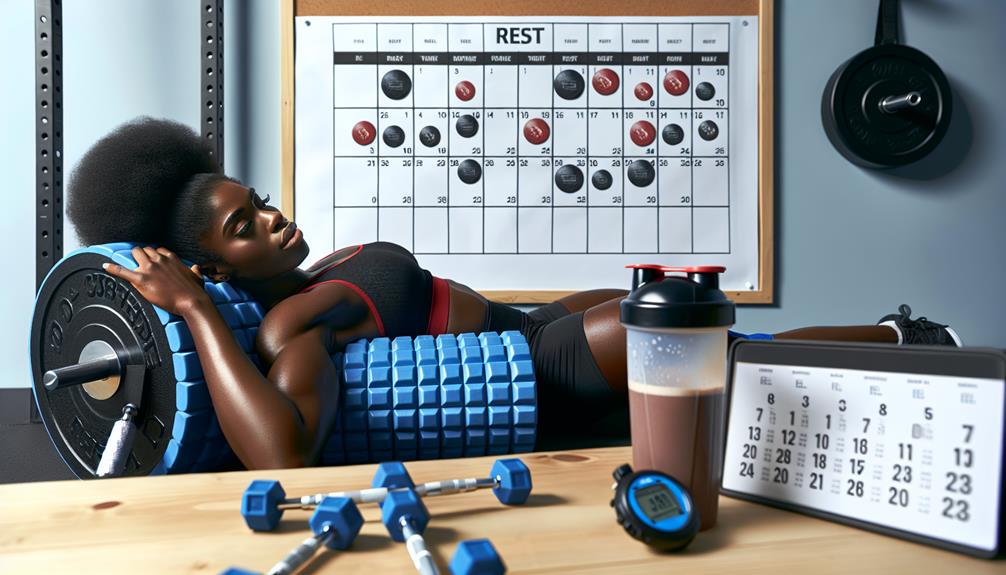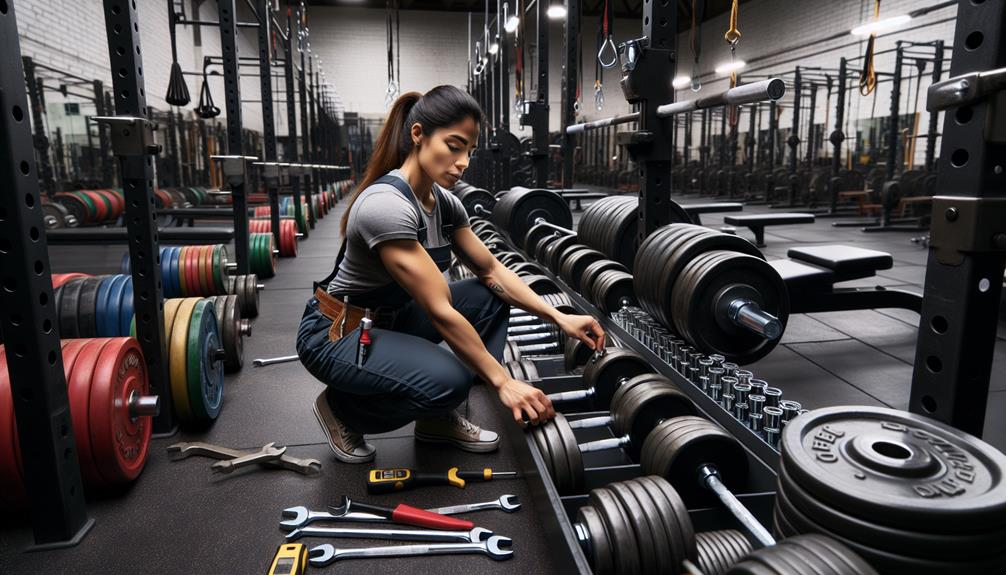Get ready for the 2024 powerlifting events with our top 10 tips. Plan your calendar details, optimize training strategies, and assess competition readiness. Focus on nutrition, rest, and mental preparation. Manage equipment, travel, and accommodation efficiently. Remember warm-up and cool-down routines, goal setting, and visualization techniques. Our tips will help you excel at the upcoming powerlifting events.
Key Takeaways
- Stay updated on 2024 powerlifting event schedules and locations.
- Plan training and competition strategies in advance.
- Focus on nutrition, hydration, and recovery for peak performance.
- Ensure equipment maintenance and efficient travel arrangements.
- Implement goal setting and visualization techniques for success.
Event Calendar Highlights
As we plan for the upcoming 2024 powerlifting events, it's crucial to highlight key dates and locations in our event calendar. Ensuring that athletes have ample time to prepare and perform at their best is essential for the success of the competitions. By strategically organizing the events in favorable locations and at optimal times, we aim to create an environment conducive to peak athlete performance.
Event preparation plays a significant role in setting the stage for remarkable displays of strength and skill. Attention to detail in logistics, equipment, and facilities can make a substantial difference in the overall experience for both competitors and spectators. We're committed to fine-tuning every aspect of the events to maximize efficiency and create a seamless competition experience for all involved.
Empowering athletes to shine on the platform is our primary goal, and meticulous event planning is fundamental in achieving this objective. By prioritizing athlete performance and event preparation, we lay the foundation for a successful series of powerlifting competitions in 2024.
Training Periodization Strategies
Highlighting effective training periodization strategies is key to optimizing athlete performance in the upcoming 2024 powerlifting events. To achieve strength gains and peak performance, athletes must follow a well-structured periodization plan that includes specific phases such as hypertrophy, strength, and peaking.
During the hypertrophy phase, focus on high volume and moderate intensity to build muscle mass. Transitioning into the strength phase, increase the intensity while decreasing the volume to enhance neuromuscular adaptations. Lastly, the peaking phase involves tapering down volume and intensity to allow for supercompensation, leading to peak performance during competition.
It's crucial to listen to your body throughout each phase, adjusting the training load as needed to prevent overtraining and maximize recovery. By strategically manipulating training variables like volume, intensity, and frequency, athletes can ensure they're at their strongest and most prepared come competition day.
Competition Selection Criteria

When considering our powerlifting event participation, we evaluate the competition selection criteria to ensure we align with the requirements for entry. Understanding the qualification standards and selection process is crucial for empowering ourselves in the competitive powerlifting realm.
Here are three key points to keep in mind:
- Qualification Standards: Familiarize yourself with the specific benchmarks set by the event organizers. Meeting these standards not only demonstrates your readiness but also opens the door to showcasing your skills on a competitive stage.
- Selection Process: Stay informed about how participants are chosen for the event. Transparency in the selection process promotes inclusivity and fairness, essential values in any sporting event.
- Personal Readiness: Beyond meeting the formal criteria, assess your personal readiness and commitment. Prepare mentally and physically to not only meet but exceed the requirements, showing your dedication to the sport and your growth as a powerlifter.
Nutrition and Hydration Tips
After understanding the competition selection criteria, the focus shifts to optimizing nutrition and hydration strategies for peak performance at the powerlifting event. Meal planning becomes crucial in ensuring that our bodies are properly fueled with the right balance of macronutrients. We prioritize whole foods rich in lean proteins, complex carbohydrates, and healthy fats to support muscle recovery and sustained energy levels throughout the competition. It's essential to avoid overly processed, sugary, or greasy foods that may lead to energy crashes or digestive discomfort.
Hydration strategies are equally important. We emphasize consistent water intake leading up to the event to maintain proper hydration levels. Electrolyte-rich beverages can also be beneficial, especially during intense training sessions or in hot environments. Monitoring our urine color is a simple yet effective way to gauge hydration status; pale yellow is the goal.
Recovery and Rest Importance

To perform at our best during a powerlifting event, prioritizing recovery and rest is crucial for optimal physical and mental readiness. Our bodies need time to repair and rejuvenate after intense training sessions. Here are three essential tips to help you maximize your recovery and rest:
- Invest in Sleep Quality: Adequate sleep is the foundation of effective recovery. Aim for 7-9 hours of uninterrupted sleep each night to support muscle repair, hormone regulation, and cognitive function. Creating a calming bedtime routine can help improve sleep quality.
- Embrace Active Recovery: Engaging in low-intensity activities such as yoga, light stretching, or leisurely walks can enhance blood circulation, reduce muscle soreness, and promote mental relaxation. Active recovery sessions can aid in faster recovery between intense workouts.
- Listen to Your Body: Pay attention to signals of fatigue, soreness, and stress. Give yourself permission to rest when needed and adjust your training schedule accordingly. Honoring your body's need for rest is essential for long-term performance and well-being.
Mental Preparation Techniques
Prioritizing mental preparation techniques is key to enhancing performance and focus during a powerlifting event. To excel in powerlifting, it's crucial to not only train the body but also the mind. Two essential techniques that can significantly impact your performance are pre-competition relaxation and visualization exercises. Pre-competition relaxation involves techniques such as deep breathing, progressive muscle relaxation, and positive self-talk to calm nerves and focus the mind. Visualization exercises, on the other hand, help you mentally rehearse your lifts, visualize success, and boost confidence.
| Mental Preparation Techniques | ||||
|---|---|---|---|---|
| Benefits | Techniques | Frequency | Duration | Tips |
| Reduces Anxiety | Deep Breathing | Daily | 5-10 mins | Focus on inhaling deeply through your nose and exhaling slowly through the mouth. |
| Enhances Focus | Progressive Muscle Relaxation | Before Competitions | 10-15 mins | Start from your toes and work your way up, tensing and relaxing each muscle group. |
| Boosts Confidence | Visualization Exercises | Weekly | 10-15 mins | Imagine yourself successfully completing each lift with perfect form and ease. |
Equipment Check and Maintenance

Ensuring our equipment is properly checked and maintained is crucial for optimal performance and safety during a powerlifting event. Regular upkeep maintenance guarantees that our gear functions at its best when we need it most.
Here are three essential tips to keep your equipment in top condition:
- Create a Checklist: Develop a comprehensive checklist covering all your powerlifting gear, including belts, shoes, knee sleeves, and wrist wraps. This ensures nothing gets overlooked, giving you peace of mind when stepping onto the platform.
- Regular Inspections: Implement a routine schedule for inspecting your equipment. Check for any signs of wear and tear, loose screws, or frayed edges. Addressing these issues promptly can prevent accidents during lifts.
- Proactive Maintenance: Don't wait for something to break before taking action. Perform regular maintenance tasks such as cleaning, lubricating moving parts, and tightening screws. Proactive upkeep prolongs the lifespan of your equipment and maintains its performance quality.
Travel and Accommodation Essentials
How can we ensure a smooth and comfortable journey to the powerlifting event while maintaining a focus on essential accommodation needs?
When it comes to travel, packing essentials is key. Make a checklist including powerlifting gear, comfortable clothing, toiletries, and any necessary medications. Remember to pack snacks and stay hydrated during the journey.
Booking accommodations in advance is crucial to secure a place that meets your needs. Look for options near the event venue to save time and energy on commute days. Consider factors like proximity to food options and rest areas for optimal convenience.
Finding lodging that offers amenities like a gym or access to ice baths can aid in post-competition recovery. Prioritize rest by selecting a quiet and comfortable place to stay. Communicate any specific requirements to the accommodation providers to ensure a pleasant experience.
Warm-Up and Cool Down Protocols
To maximize performance and prevent injury, our team incorporates dynamic warm-up and thorough cool-down routines before and after powerlifting events. Dynamic stretching helps to activate muscles and improve range of motion, preparing our bodies for the intense lifts ahead.
Foam rolling is another key component of our routine, aiding in muscle recovery and reducing muscle tightness post-competition. Here are three essential tips for optimizing your warm-up and cool-down protocols:
- Embrace Movement: Engage in a variety of dynamic stretches that mimic the movements you'll perform during the competition. This not only warms up your muscles but also enhances your mind-muscle connection.
- Prioritize Recovery: Allocate time for foam rolling after your lifts. This practice helps release muscle tension, promoting faster recovery and reducing the risk of injury.
- Listen to Your Body: Pay attention to how your body responds to different warm-up and cool-down techniques. Adjust your routine to suit your individual needs and preferences, empowering yourself to perform at your best.
Goal Setting and Visualization Techniques
We incorporate goal setting and visualization techniques to enhance our performance and mental preparation for powerlifting events. By setting clear and achievable goals, we provide ourselves with a roadmap for success. These goals serve as beacons, guiding our training and competition strategies.
Through visualization, we vividly imagine ourselves executing perfect lifts, feeling the weight in our hands, hearing the cheers of the crowd, and embracing the sense of accomplishment. This mental rehearsal not only boosts our confidence but also primes our muscles for optimal performance.
Visualization benefits us by creating a powerful connection between our minds and bodies, helping us perform at our peak when it matters most. By visualizing success, we program our subconscious minds for goal achievement, reinforcing our belief in our abilities.
As we step onto the platform, we carry with us the mental readiness cultivated through our visualization practices, ready to conquer the challenges ahead and achieve our powerlifting goals.
Frequently Asked Questions
What Is the Recommended Attire for Spectators at Powerlifting Events?
When heading to powerlifting events, we opt for comfy attire that respects the sport and fellow attendees. Spectator etiquette suggests casual wear like athletic gear or jeans. Keep it sporty, stay comfortable, and enjoy the show!
Are There Any Specific Rules Regarding Photography and Recording During Competitions?
When it comes to powerlifting competitions, there are strict photography rules and recording regulations in place to ensure fair play and preserve the integrity of the event. It's important to follow these guidelines respectfully.
How Are Tiebreakers Determined in Powerlifting Competitions?
In powerlifting competitions, tiebreakers are determined based on judging criteria like body weight. If lifters have the same total, the lifter with the lower body weight wins. It's a fair way to break ties.
Are There Any Restrictions on the Use of Personal Music Devices During Warm-Up Sessions?
During warm-up sessions, personal music devices are allowed. They can help us get in the zone and focus on our lifts. It's liberating to have our favorite tunes motivating us before hitting the platform.
Can Athletes Bring Their Own Chalk or Are There Specific Regulations on Its Use During Lifts?
Absolutely, athletes can bring their own chalk for lifts! There are minimal regulations on its use, ensuring athletes have the freedom to use their preferred equipment. It's a game-changer, helping us grip like superheroes!
Conclusion
Overall, staying on top of the powerlifting event schedule for 2024 is crucial for success. By following these top 10 tips, we can ensure we're prepared, focused, and ready to dominate the competition.
With dedication and hard work, we can reach new heights and achieve our wildest powerlifting dreams. Let's lift our way to glory and show the world what we're made of!













